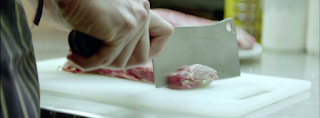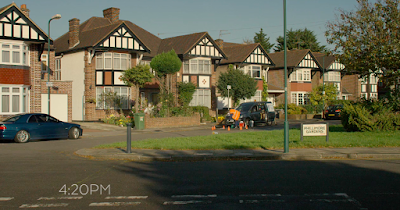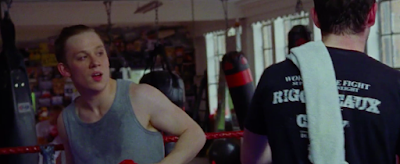The Ellington Kid
|
|
| The film begins in close up, with a knife cutting some meat. This shot sets the tone for the rest of the film as it foreshadows events that occur later in the film, surrounding the topic of knife crime. The use of a close up means that the viewer can't see who is using the knife, which builds tension, whilst the use of artificial lighting mimics the bright light used in kebab shops and suggests that it is night time, which adds to the sense of unease for the spectator. The characters are seen in the centre of the frame, filmically stating that these are the main characters, with the boy on the left being the main protagonist and narrator of the film. The bright colours of the chairs and clothing, combined with a use of natural lighting, helps to create a more relaxed, daytime atmosphere. This provides a strong contrast with the flashbacks that are filmed at night, and are used to build a tense, unsettling atmosphere. The medium shot of the boys immediately creates humour, even before the introduction of dialogue, as the boy on the left appears to be noticeably smaller, yet he is telling the story to scare the boy on the right. |
|
|
| The mis-en-scene is important in this shot, with the barbed wire fence in the background emphasising the fact that there is no escape, which in turn heightens the danger and builds tension. The boy's hood is up, which results in chiaroscuro type lighting being projected onto his face, adding an element of mystery to the situation. The use of the over the shoulder shot, disallows the audience to see the face of the attacker, adding to the distressing nature of the film. Overall, the lighting is dark, with only minimal bright light being emitted from the cars in the distance. This darkness creates a sense of isolation, whilst potentially reflecting the dark comedy that is seen throughout the film. |
|
|
| The bright lighting of the Kebab shop is suggestive of hope, and contrasts with the dark, closed shops on either side of it, perhaps lending godlike qualities to the shop. The shot of the back of his head denies the spectator a view of his wound, furthering the sense of mystery and building tension. It also means that the attackers cannot be seen, so the distance between him and them is left up to the viewer's imagination. The car comes into the shot, which furthers the tension as small events are heightened throughout the film to keep the viewer on edge, maintaining the level of tension. |
|
|
| The eye line shot of the victim creates empathy as his level of desperation is visible through his facial expressions. It also helps to show how the worker is towering over him as his legs appear to be far bigger than the victim's body. This builds tension as the viewer doesn't know whether he will help him or not. This question is emphasised by the shots of the knife cutting the meat at the beginning of the film. The bright light contrasts with the dark lighting where the victim was stabbed. This creates a sense of spotlight lighting as his hoodie blends into the wall, which emphasises his features. It also adds an element of disorientation to the film. |
|
|
| The knife is pointing towards the camera but not directly at it. This adds tension as the viewer cannot see the facial expressions of the kebab shop worker. The low angle shot of the gang member makes him seem more intimidating, which adds to the tension. The bright artificial lighting contrasts with his black clothing, which allows him to both physically and metaphorically, appear darker. |








Comments
Post a Comment